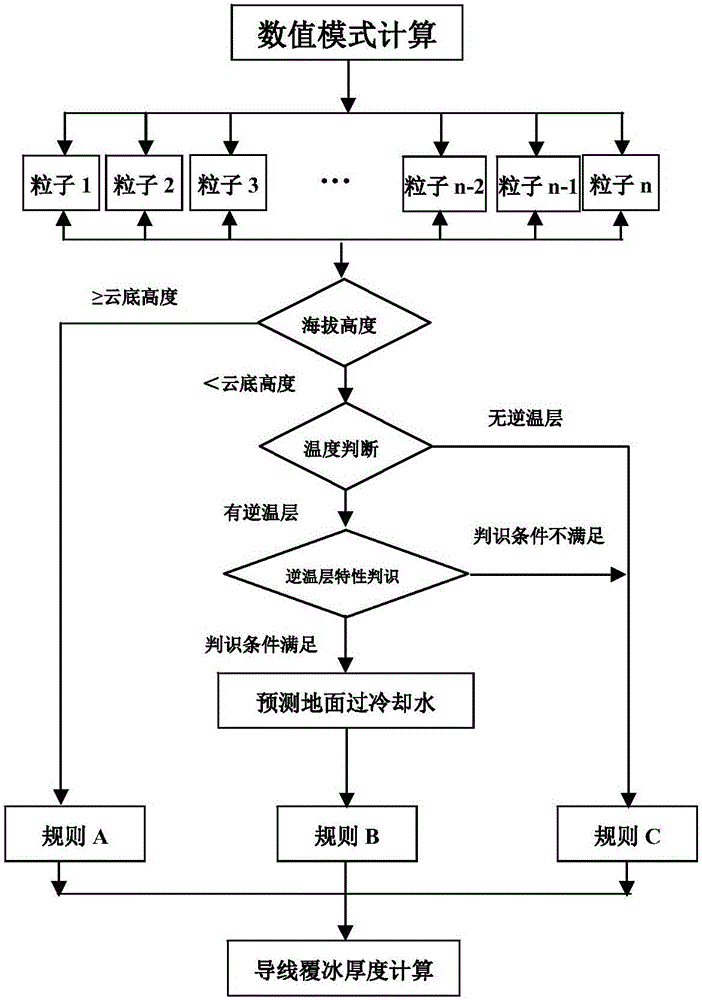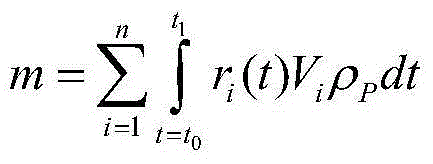Ground cooling water prediction method based on rainfall particle phase transition process
A technology of precipitation particles and prediction methods, applied in the field of power transmission and distribution, can solve the problems of failing to reflect the phase transition process of precipitation particles, prediction deviation of ground supercooled water, and insufficient analysis of specific characteristics, so as to achieve clear regulation and ensure safety and stability. Operational and practical effects
- Summary
- Abstract
- Description
- Claims
- Application Information
AI Technical Summary
Problems solved by technology
Method used
Image
Examples
example 1
[0041] (1) Basic database construction.
[0042] Establish a basic database with the altitude data of the micro-topographic area and the basic information of the transmission line tower.
[0043] (2) Numerical mode calculation.
[0044] Using the WRF numerical model, design the parameter scheme, initial conditions and boundary conditions of the model operation, and predict the content of cloud water, rain water, cloud ice, snow and graupel in the atmosphere, the temperature field from the ground to the upper air at different levels, and the height of the cloud base.
[0045] (3) Altitude comparison.
[0046] At the same ground coordinate point, the cloud base height predicted by the numerical model in step (2) is compared with the altitude in the basic database established in step (1). It is judged that the height of the cloud base ≤ the altitude of the ground.
[0047] (6) Calculation of ground subcooling water content.
[0048] then from t 0 start at time, predict t 1 ...
example 2
[0053] Step (1), (2) with example 1
[0054] (3) Altitude comparison.
[0055] At the same ground coordinate point, the cloud base height predicted by the numerical model in step (2) is compared with the altitude in the basic database established in step (1). It is judged when the height of the cloud base > the altitude of the ground.
[0056] (4) Identification of temperature stratification.
[0057] It is judged that there is a 0°C layer in the temperature stratification from the ground to the cloud base, and the height of the 0°C layer is recorded as H. And it is satisfied that when the height is less than H, the atmospheric temperature is 0°C, which is recorded as a temperature inversion layer.
[0058] (5) Identification of ground supercooled water.
[0059] The temperature stratification in the micro-topography area satisfies the maximum temperature of the warm layer > 4°C, and the ground temperature is < 0°C. It is judged that the precipitation particles falling to th...
example 3
[0067] Step (1), (2), (3) are the same as example 2
[0068] (4) Identification of temperature stratification.
[0069] There is no 0°C layer in the temperature stratification from the ground to the cloud base, so it is judged that there is no supercooled water on the ground.
[0070] (6) Calculation of ground subcooling water content.
[0071] The ground subcooling water content is 0.
[0072] (7) Calculation of conductor ice thickness.
[0073] The wire ice thickness is 0.
PUM
 Login to View More
Login to View More Abstract
Description
Claims
Application Information
 Login to View More
Login to View More - R&D
- Intellectual Property
- Life Sciences
- Materials
- Tech Scout
- Unparalleled Data Quality
- Higher Quality Content
- 60% Fewer Hallucinations
Browse by: Latest US Patents, China's latest patents, Technical Efficacy Thesaurus, Application Domain, Technology Topic, Popular Technical Reports.
© 2025 PatSnap. All rights reserved.Legal|Privacy policy|Modern Slavery Act Transparency Statement|Sitemap|About US| Contact US: help@patsnap.com



